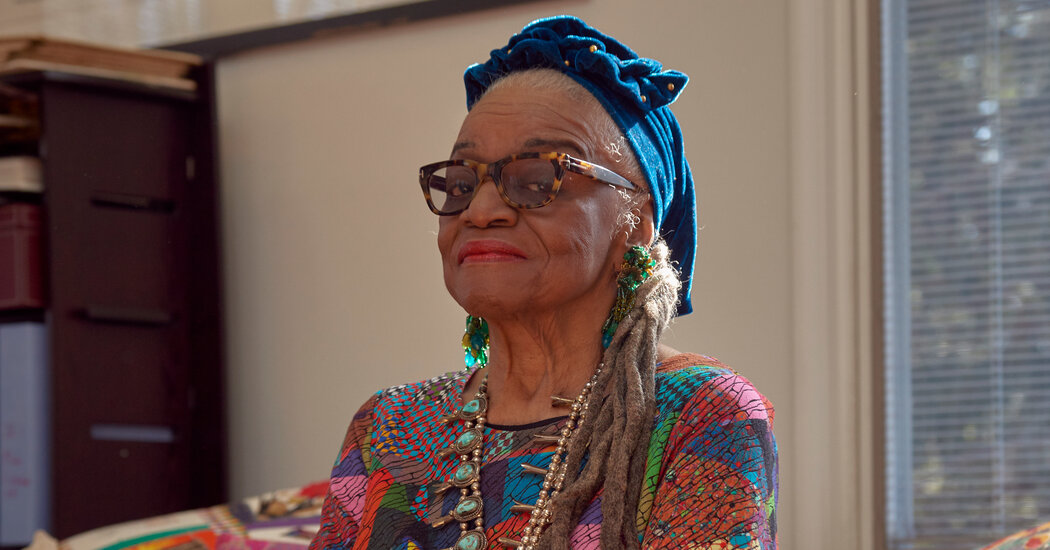Faith Ringgold, who died Saturday at 93, was an artist of protean inventiveness. Painter, sculptor, weaver, performer, writer and social justice activist, she made work in which the personal and political were tightly bonded. And much of that work gained popularity among audiences that didn’t necessarily frequent galleries and museums. This was particularly true of her series of semi-autobiographical painted narrative quilts depicting scenes of African American urban childhood, subject matter that translated readily into illustrated children’s books, of which, over the years, Ringgold published many.
Altogether, hers added up to a landmark-status career. But the art establishment, as defined by major museums, big-bucks auction houses and a few talent-hogging galleries, never knew quite what to do with it, or with her. So they didn’t do anything. No mega-surveys, no million-dollar corporate commissions, no Venice Biennale-type canonizations.
Recently, though, very late in the day, came a serious uptick in attention. In 2016, the Museum of Modern Art finally brought Ringgold into its collection with the acquisition of several pieces from early in her career. One of them was a monumental 1967 painting titled “American People Series #20: Die.” It shows a crowd of panicked men, women and children, white and Black, screaming and bleeding, and stampeding in all directions as if under lethal attack from some unseen force.
It’s useful to remember where Ringgold stood in her life at the time she painted the picture. Harlem-born, she’d had a classical art education, was teaching art in public school, and was painting what she herself described as Impressionist-style landscapes. She was also reading James Baldwin, listening to the news, and seeing American racial politics shift from civil rights-era passive resistance to a newly assertive Black power. The country was on red alert, just as it is today, and her art responded to the emergency by turning topical.
In the paintings she called the “American People Series,” of which “Die” was one, white people and Black people appear together, but with skewed power balances made clear. In an early picture, “The Civil Rights Triangle” from 1963, five men in business suits, four Black, one white, form a pyramid, with the white man on top, indicating that to the extent the civil rights movement was white-approved, it was also white-controlled.
In “Die,” the culminating picture in the series, a full-on war has erupted, though one that goes beyond being a clear-cut race war. All the figures in the picture look equally stunned and traumatized by the blood bath they find themselves in.
And for Ringgold at this time, art itself went beyond being the seismic recorder of a culture. It also became a vehicle for path-clearing and ethical advocacy. She organized protests against the exclusion of Black artists from leading museums, and designed posters in support of the Attica inmates and the activist Angela Davis. In a painting series called “Black Light,” she eliminated white pigment from her palette and mixed black into all her colors. By the 1970s she had become convinced that Black liberation and women’s liberation were inseparable causes. In 1971 she painted a mural for what was then the Women’s House of Detention on Rikers Island.
She knew that the country she lived in was actively, murderously crazy. For an artist to find a voice for that craziness, to get the pitch of the madness right, was unusual and daring. For that artist to be Black and female was more than unusual, and met with pushback from many sources, most of them within the art world itself.
The kind of painting she favored — figurative, storytelling, polemical — was out of fashion with the establishment, which well into the ’60s touted abstraction as the only “serious” aesthetic mode. (Even within Black art circles a debate over whether modern art, Black or otherwise, should admit political content was very much alive.) And her work continued to run against the grain throughout the Minimalist and Conceptualist years. It’s only recently, with figurative painting hugely in vogue, that her work has gained something like market currency.
And over the decades she continued to develop in new directions. Her formal means grew ever more craft-intensive, incorporating weaving, sewing and carving. Her political content drew less from the news and more from art history and her own life. Her determination to share this content, often determinedly Black-positive in tone, with young audiences through 20 published children’s books is all but unique in contemporary art annals.
The full range of these developments was on display in an overdue retrospective, “Faith Ringgold: American People,” organized by the New Museum in 2022. But back to Ringgold at MoMA in 2019.
For the opening of its newly expanded premises, the museum was rehanging, top to bottom, its permanent collection galleries, and “Die,” a relatively recent arrival, was chosen for inclusion. More than that, it was awarded a starring role. It shared an otherwise sparsely installed gallery with a major MoMA attraction, Picasso’s 1907 “Les Demoiselles d’Avignon,” a confrontational image of five nude Catalan prostitutes with sliced-up bodies and faces like African masks.
The two paintings were placed cater-corner in the gallery, so you could take them in together at a glance. Both are violent. (The colonialist implications of “Demoiselles” have been much noted, and art historians have read the picture as, among other things, an expression of male sex panic.) Both register as scorchingly political, while leaving their precise politics unclear. Paired at MoMA, they seemed to be visually and conceptually duking it out.
For me, Ringgold — an avowed Picasso fan — won the match. But what really mattered was simply that she was there, smack in the center of Western Modernism’s ground zero institution, and with her most radical image. I admire Ringgold’s later art, much of it materially innovative and expressively buoyant. But it’s the early work, from the pivotal period that produced “Die,” that I keep coming back to.
What she managed to do, in those early paintings, was put aside all the conventional art tools she’d been schooled with, beauty among them (she would later reclaim it), in order to face down the world as it really was, including an art world that had no use for her — a Black woman — and was, in fact, fortressed to keep her and everyone like her out.
Certain artists manage to leap over walls. Picasso was one. And some tunnel under those walls, hit resistance, tunnel some more and, once inside, open a door to let others in. That’s what Faith Ringgold, artist-activist to the end, did.

